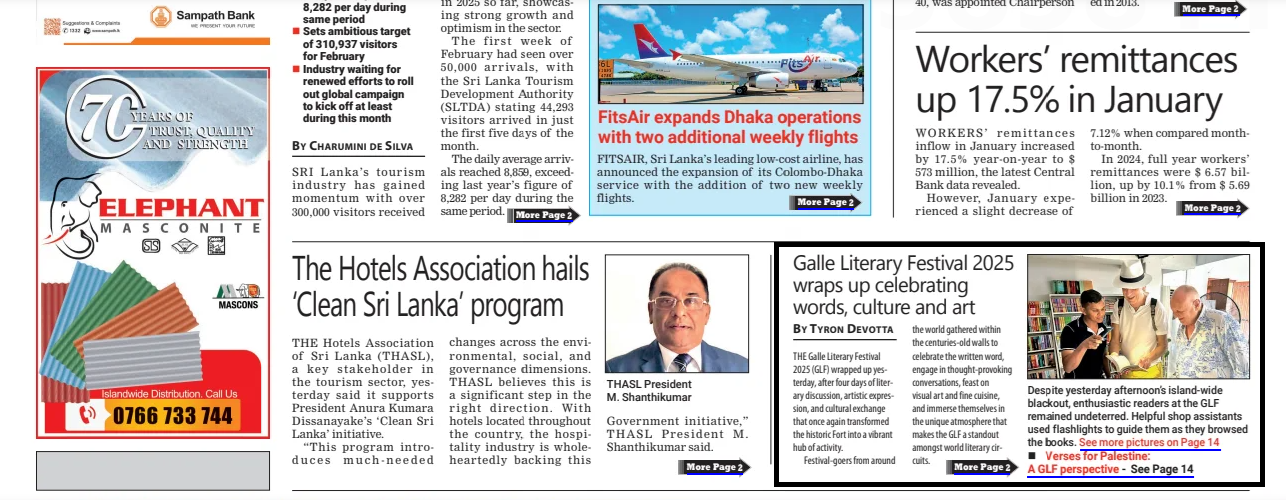By Tyron Devotta
Writing short stories for the media is an art form—one that demands a deep understanding of the world around us, more than a need to express our own thoughts. In today’s fast-paced media landscape, relevance is everything. It’s not just about what you want to say, but how it fits into the broader narrative. This is especially true when writing press releases. If you want to catch an editor’s attention, you must understand that your story alone is not enough. What matters is where it fits in the bigger picture: how it complements the publication’s goal to capture attention and increase readership. Even the simplest stories must connect to a larger, timely, and often national context.
Galle Lit Festival
Take, for example, a recent experience of mine. Although I currently contribute as a guest columnist to a national newspaper—where I usually write opinion pieces—this time I was asked to switch roles and go back to my reporting roots. The assignment was to cover the Galle Literary Festival, held earlier this year.
What made this opportunity even more special was that I got to work alongside my daughter, who was also assigned to cover the Art Trails segment of the festival. Over the course of the event, I produced several in-depth features. But the challenge came on the final day, a Sunday, when I got instructions from the newspaper asking for pictures from the festival—specifically, a Page 1 photo. I had just two hours to deliver.
Looking for a pic
With my daughter by my side, we drove through Galle Fort, stopping at various events—panel discussions, cookery demos, documentary screenings, art exhibits—snapping photos along the way. But as time slipped away, I still hadn’t found the photo.
When my daughter asked what I would do if I didn’t find it, I told her confidently, “I will.”
Then came a call from my wife in Colombo, informing me of a nationwide power outage—the infamous “monkey power cut,” as some may remember. That sparked an idea. Our next stop was the Sarasavi Bookshop at the festival. It was dimly lit due to the outage. Inside, I spotted a scene that captured everything I was looking for: a shop assistant holding his phone’s flashlight over a book that two customers were browsing. I took the shot, and it was, indeed, the Page 1 photo for the Daily FT.

The Formula
What made that photo work? What makes any good story stand out—especially when you're tasked with turning routine PR material into newsworthy content? It’s all about connecting the micro to the macro. In this case, I linked a cultural event—the literary festival—to a nationwide news event, the power cut. Though the power outage was a negative story, it became an uplifting one through the way I framed it, emphasizing the resilience of the human spirit.
As PR professionals, we often face pressure from clients who want to control every detail of a press release. When you’re fortunate enough to work with a client who trusts you, it’s more than luck—it’s a recognition of your ability to identify what truly works. Crafting a compelling story often relies more on intuition than logic. It’s a gut instinct, a trait as old as human civilization itself.
Cooperation
Historian Yuval Noah Harari, in his books Sapiens and Homo Deus, writes that humans dominate the world not because of their intelligence, but because of their ability to cooperate in large numbers. What enables that cooperation, he argues, is the power of shared stories. People don’t need to know each other personally; they just need to know the same story. This shared narrative becomes the glue of human society—connecting billions through something as vast as religion, or as intimate as a myth.
Take, for example, the story of Santa Claus. Many believe in him as if he were a real person. And in a way, he is—made real by belief, tradition, and powerful storytelling. In 1931, Coca-Cola commissioned artist Haddon Sundblom to paint Santa Claus for their holiday ads. Sundblom portrayed him as a warm, jolly, grandfatherly figure dressed in Coca-Cola’s signature red and white. Though red was already commonly used in depictions of Santa, Sundblom’s version standardized and popularized it. His illustrations—featured in magazines, posters, and billboards—became so iconic. The truth is, they cemented his image in the global imagination. Even years after Sundblom stopped painting Santa, his art continued to be reused because of its lasting emotional resonance.
And that’s the essence of great storytelling—relevance and emotional connection. A compelling story must do more than inform; it must resonate. It must connect with the audience’s experiences and emotions on the day they encounter it. Editors, who are flooded daily with potential stories, instinctively look for these traits. Their job is to pick the stories that will hold a reader’s attention, and the best way to ensure your story makes the cut is to make it relevant—to plug it into the macro narrative of the moment.
Because in the end, the stories that succeed are the ones that tap into something bigger than themselves.
Tyron Devotta is a communications professional with 44 years of experience. He has worked as a correspondent on the frontlines during the war years in Sri Lanka and has been a reporter on the news and investigation desks of several English newspapers. He has also been a Business Editor and Deputy Editor of two national newspapers with work experience with international news teams from CNN, German Television (ARD), and Deutsche Welle (DW) in Sri Lanka. Devotta was also the News Director for a leading private media organization for eight years, managing a trilingual newsroom that delivered news to three television channels and four radio stations. Fluent in English, Sinhala, and Tamil, he is currently a columnist for Daily FT and a Public Affairs consultant.



